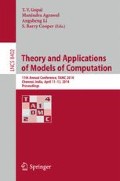Abstract
Spiking neural P systems with anti-spikes (in short, SN PA systems) are membrane systems that communicate using two types of objects called spikes and anti-spikes, inspired by neurons communicating through excitatory and inhibitory impulses. This paper shows that computational completeness in an SN PA systems can be achieved with neurons having only two pure spiking rules of the form a → a and \(a\rightarrow \overline{a}\) without any forgetting rules. We also construct a small universal SN PA system with 91 simple neurons i.e., neurons having only one rule of the form \(a\rightarrow \overline{a}\) or a → a.
Access this chapter
Tax calculation will be finalised at checkout
Purchases are for personal use only
Preview
Unable to display preview. Download preview PDF.
References
Păun, G., Rozenberg, G., Salomaa, A. (eds.): Handbook of Membrane Computing. Oxford University Press (2010)
Rozenberg, G., Salomaa, A. (eds.): Handbook of Formal Languages, 3 volumes. Springer, Berlin (1998)
Korec, I.: Small universal Turing machines. Theoretical Computer Science 168, 267–301 (1996)
Pan, L., Păun, G.: Spiking Neural P Systems with Anti-Spikes. International Journal of Computers, Communications and Control 4(3), 273–282 (2009)
Ionescu, M., Păun, G., Yokomori, T.: Spiking Neural P Systems. Fundamenta Informaticae 71, 279–308 (2006)
Minsky, M.: Computation finite and infinite machines. Prentice Hall, Englewood Cliffs (1967)
Song, T., Pan, L., Wang, J., Venkat, I., Subramanian, K.G., Abdullah, R.: Normal Forms of Spiking Neural P systems with anti-spikes. IEEE Transactions on Nanobioscience 11(4), 352–359 (2012)
Song, T., Jiang, Y., Shi, X., Zeng, X.: Small Universal Spiking Neural P Systems with Anti-Spikes. Journal of Computational and Theoretical Nanoscience 10(4), 999–1006 (2013)
Zeng, X., Zhang, X., Pan, L.: Homogeneous spiking neural P systems. Fundamenta Informaticae 97(12), 1–20 (2009)
Author information
Authors and Affiliations
Editor information
Editors and Affiliations
Rights and permissions
Copyright information
© 2014 Springer International Publishing Switzerland
About this paper
Cite this paper
Metta, V.P., Kelemenová, A. (2014). Universality of Spiking Neural P Systems with Anti-spikes. In: Gopal, T.V., Agrawal, M., Li, A., Cooper, S.B. (eds) Theory and Applications of Models of Computation. TAMC 2014. Lecture Notes in Computer Science, vol 8402. Springer, Cham. https://doi.org/10.1007/978-3-319-06089-7_25
Download citation
DOI: https://doi.org/10.1007/978-3-319-06089-7_25
Publisher Name: Springer, Cham
Print ISBN: 978-3-319-06088-0
Online ISBN: 978-3-319-06089-7
eBook Packages: Computer ScienceComputer Science (R0)

